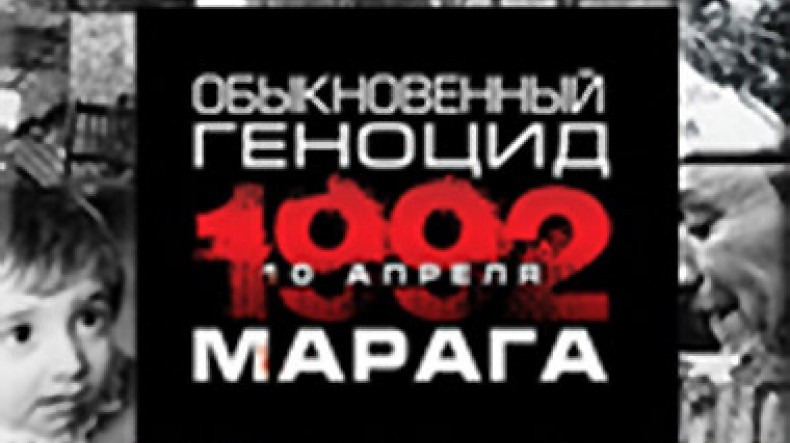
Maragha slaughter anniversary: History repeats itself after 24 years in Karabakh village of Talysh
Twenty-four years have passed since "Maragha." On April 10, 1992, after a 3-hour artillery preparation, the subunits of the Azerbaijani regular army invaded the peaceful village in Karabakh. The attack was not dictated by military necessity. Over 100 people, mainly women, children, and old people, fell victims to the aggression. Civilians were killed in a cruellest manner: they were dismembered, burnt alive, beheaded, thrown under tanks, or cut with axes. About 50 people were taken hostages, including 9 children. While in captivity, many Maragha residents were tortured, humiliated, and subjected to an inhuman treatment. Some of them were later exchanged, but the fate of many is still unknown. In about two weeks, on April 22-23, Maragha was again attacked, and the people, who had returned to the site of fire, had to leave the native village forever. Currently, Maragha is under Azerbaijani occupation.
The chronicle of those days is terrifying, and it is not surprising that Baroness Caroline Cox called Maragha “contemporary Golgota.”
“The name of this village is associated with a massacre which never reached the world’s headlines, although at least 45 Armenians died cruel deaths. During the CSI mission to Nagorno Karabakh in April, news came through that a village in the north, in Mardakert region, had been overrun by Azeri-Turks on April 10 and there had been a number of civilians killed. A group went to obtain evidence and found a village with survivors in a state of shock, their burnt-out homes still smoldering, charred remains of corpses and vertebrae still on the ground, where people had their heads sawn off, and their bodies burnt in front of their families. 45 people had been massacred and 100 were missing, possibly suffering a fate worse than death.” This is how Baroness Caroline Cox describes the tragedy of Maragha, a village in Karabakh, in her book “Ethnic Cleansing in Progress: War in Nagorno Karabakh” (co-author: John Eibner).
The stories of the survivors, who currently live in the village Nor (New) Maragha, leave no doubt that what happened in the Karabakh village on that day completely matches the definition of genocide provided by a respective UN Convention. Back in 1997, the Armenian side submitted documents and facts about the tragedy in Maragha to the UN Human Rights Committee. The process could not be accomplished then. However, the Armenian side intends to introduce the Maragha dossier to international agencies once again in the frameworks of An Ordinary Genocide project.
Remarkably, ShahinTalibogluTagiyev, the commander of Gurtulush battalion, which attacked the village committing that crime against humanity, was named the first national hero of independent Azerbaijan. This was a continuation of the shameful tradition of heroization of murderers of Armenians, which started with “sumgait” and was continued later in the case of RamilSafarov, the Budapest maniac.
The events in Maragha were preceded by a tragedy of the residents of destroyed and burnt village Khramort, where six elderly inhabitants, unable to escape from the approaching Azerbaijani army, had been cruelly murdered. Armenian fighters and a Russian journalist found their disfigured bodies after the village was liberated.
The tragic fates of the residents of Armenia and the Nagorno Karabakh Republic (Manvel Saribekyan and Karen Petrosyan) can be added to the list. Appearing in the territory of the Azerbaijan Republic in the period of the so-called 1994 “truce,” they were tortured in a way that led to their death.
The recent events in the village Talysh (NKR) also remind of “Maragha.” On April 2, 2016, Azerbaijani divisions, including armed cap-a-pie mercenaries, managed to invade the village. The atrocities committed by them and later photographed by reporters shocked the public. The Azerbaijani saboteurs shot elderly civilians Valera Khalapyan and his wife Razmella, and cut their ears. They also shot the aged and helpless Marusya Khalapyan (born in 1924.)
During the recent escalation in the Karabakh conflict zone, the bodies of the soldiers of the NKR Defense Army were also subjected to atrocities: their heads, ears, limbs were cut, and later the photos with the terrible “trophy” were spread on social media.
About a quarter century has passed since Maragha events. However, the history repeats itself evidencing that such incidents are not accidental, but regular -- the unfolded events are a result of Azerbaijan’s targeted policy and the anti-Armenian hatred promoted by the government. Otherwise, a criminal case would have been initiated into at least one of the episodes during all these years, and the perpetrators would have been punished.
The history repeats itself again and againalso with the silent connivance and ignoring of the civilized world.
With the efforts of the Information and Public Relations Center of the Administration of the President of Armenia, a documentary “Maragha, 10 April 1992. An Ordinary Genocide" was shot, the eyewitness accounts, photos and videos taken on that fearsome day were compiled. The website maragha.org functions. Materials on Maragha slaughter are also available on karabakhrecords.info.
Related news
- Armenian rights defenders call to hold Azerbaijan responsible for military crimes
- Baroness Caroline Cox: Reports about massacre of Armenians in Maragha never reached the world’s headlines
- Maragha massacre eyewitnesses: Dismembered corpses were all around, many people were crushed under tanks
- Larisa Alaverdyan: Azerbaijan perpetrated genocide in Maragha
Newsfeed
Videos






























